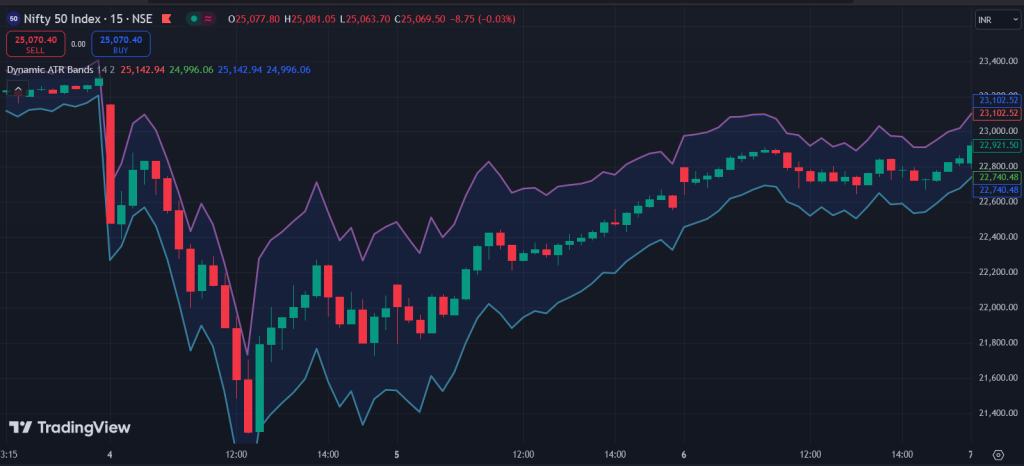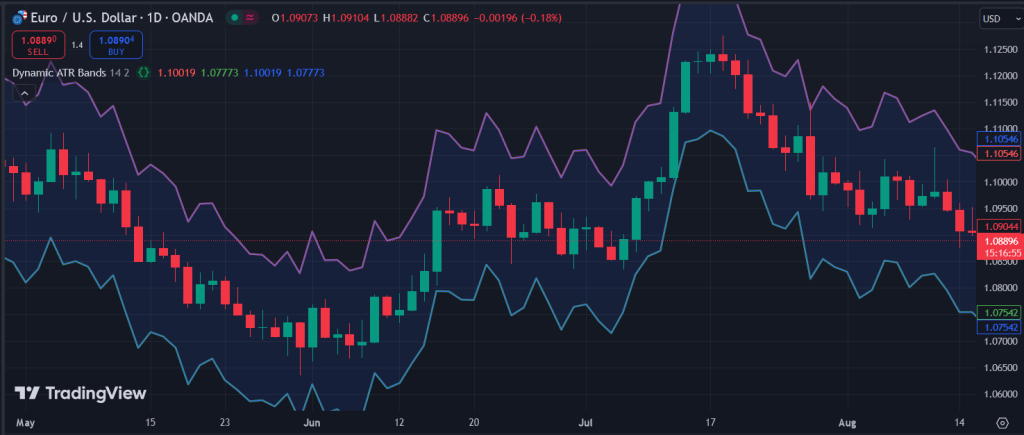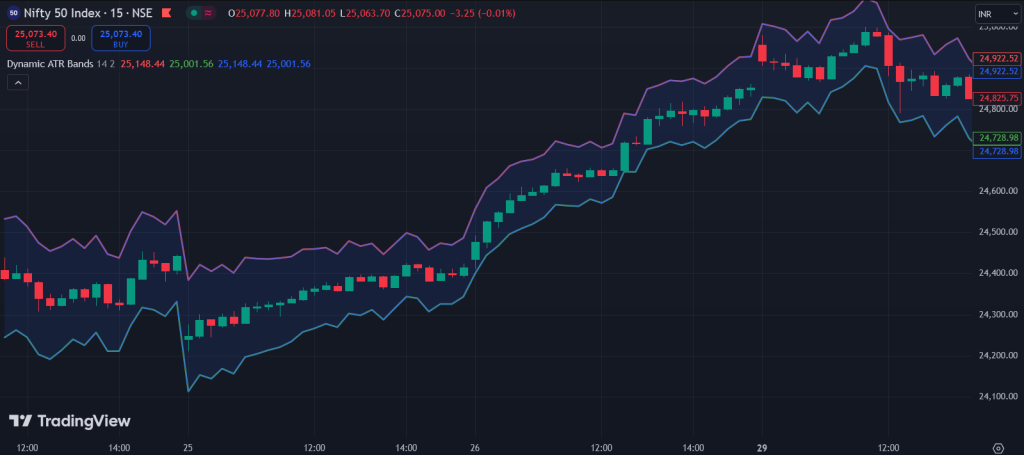🔓 Get All Tools for FREE!
- ✅ Click here to open a trading account using our referral link and start trading.
- 📅 After 7 days of active trading under our referral link, you can get access to all tools in your account.
- ⚠️ Keep trading to keep access free — if you're inactive for 7 days, your access will be removed.
- 👉 Already have an account? You can change the IB (introducing broker) to our referral link ( https://one.exnesstrack.org/a/w7syl3vnjb ) and still qualify!
In today’s fast-paced trading environment, understanding market volatility is essential for traders looking to make informed decisions. One powerful tool that helps traders assess market volatility is the Dynamic ATR Bands Indicator. Derived from the popular Average True Range (ATR), this indicator offers valuable insights into price movements by creating bands around a moving average. These bands dynamically expand and contract based on market conditions, allowing traders to interpret potential breakouts, trends, or consolidations effectively.
In this article, we’ll dive deep into what the Dynamic ATR Bands indicator is, how it works, and how you can use it to improve your trading strategy.
What is the Dynamic ATR Bands Indicator?
The Dynamic ATR Bands Indicator is a technical analysis tool designed to help traders visualize market volatility. It uses the Average True Range (ATR) to measure volatility and then plots upper and lower bands around a moving average. These bands widen when volatility increases and contract during low volatility periods.
🔓 Get All Tools for FREE!
- ✅ Click here to open a trading account using our referral link and start trading.
- 📅 After 7 days of active trading under our referral link, you can get access to all tools in your account.
- ⚠️ Keep trading to keep access free — if you're inactive for 7 days, your access will be removed.
- 👉 Already have an account? You can change the IB (introducing broker) to our referral link ( https://one.exnesstrack.org/a/w7syl3vnjb ) and still qualify!
Unlike static indicators, the Dynamic ATR Bands adjust in real-time, making them a versatile option for traders who need to adapt to changing market conditions. This indicator is particularly popular in markets where volatility plays a crucial role in price action, such as forex, commodities, and stocks.
Key Features:
- Dynamic Nature: The bands adjust automatically based on volatility, offering a real-time view of market conditions.
- Customizable: Traders can tweak the ATR period and band width to suit their trading style or market conditions.
- Volatility Insight: It provides clear visual cues about potential trend reversals, consolidations, and breakouts.

How Does the Dynamic ATR Bands Indicator Work?
To understand how the Dynamic ATR Bands Indicator works, it’s important to first grasp the concept of the Average True Range (ATR). The ATR measures the average range between the high and low prices over a specified period. It helps traders determine how much an asset’s price moves in a given timeframe, thereby indicating market volatility.
The Dynamic ATR Bands Indicator takes this data and applies it in the following ways:
- Upper and Lower Bands: The indicator creates two bands—an upper band and a lower band—by adding and subtracting the ATR value from a moving average.
- Dynamic Expansion and Contraction: As market volatility increases, the ATR value rises, causing the bands to expand. Conversely, when volatility drops, the ATR value decreases, bringing the bands closer together.
- Market Environment Insights: By observing the behavior of the bands, traders can gauge the current market environment:
- Contracting Bands often indicate a sideways or consolidating market, signaling a low volatility period. This phase is often described as the “calm before the storm” since it can precede significant price movements.
- Expanding Bands suggest increased volatility and the potential for a new trend to emerge, making it an ideal time for traders to consider trend-following strategies.
Using the Dynamic ATR Bands in Trading
The Dynamic ATR Bands Indicator is a versatile tool that can be incorporated into a wide range of trading strategies. Here are some practical ways to use it:
- Identifying Consolidation Periods:
- When the bands contract, it typically signifies that the market is in a period of low volatility, often referred to as consolidation. During these periods, price tends to move sideways within a narrow range.
- Traders can use this phase to prepare for potential breakouts, as contraction periods are often followed by sharp price movements.
- Spotting Trend Beginnings:
- Expanding bands are a strong indication of increasing volatility and can signal the start of a new trend. This is especially useful for traders who use trend-following strategies.
- For example, when the bands begin to expand after a period of contraction, it might be a good time to enter a position in the direction of the emerging trend.
- Setting Stop-Loss Levels:
- Since the bands adjust based on market volatility, they can be a great guide for setting stop-loss levels. Traders can place their stop-losses just outside the ATR bands, ensuring that their positions are protected without being too tight.
- Volatility Breakout Strategy:
- Traders can develop a volatility breakout strategy using the Dynamic ATR Bands. When the price breaks above the upper band or below the lower band during a period of expansion, it can serve as a potential trade signal.
- However, it’s important to combine this signal with other technical indicators, such as volume, to confirm the breakout.
Customization Options in the Dynamic ATR Bands Indicator
One of the standout features of the Dynamic ATR Bands Indicator is its customization options. By adjusting key parameters, traders can fine-tune the indicator to better suit their trading strategy and the market they are trading.
- ATR Period:
- The default setting for the ATR period is often 14, but traders can adjust this value based on their preferences. A shorter ATR period will make the bands more responsive to short-term volatility, while a longer period will smooth out the bands and make them less sensitive to quick price fluctuations.
- Band Width:
- Another customization option is the width of the bands. By increasing or decreasing the multiplier used to calculate the bands, traders can make the bands more or less reactive to market volatility. A higher multiplier will result in wider bands, offering more room for price movement before a breakout signal is triggered.
Limitations of the Dynamic ATR Bands Indicator
While the Dynamic ATR Bands Indicator is a powerful tool, it’s important to understand its limitations:
- Sensitivity to Market Noise:
- In markets with frequent price fluctuations, the bands can react to short-term volatility, leading to false signals. Traders should avoid relying solely on this indicator for trade decisions and should consider using additional tools such as trend indicators or volume analysis.
- No Breakout Timing Guarantee:
- Although expanding bands indicate increased volatility and the potential for a breakout, the indicator doesn’t specify when the breakout will happen. Traders must stay vigilant and combine this indicator with others for precise entry and exit points.

Pinescript code for "Dynamic ATR Bands Indicator"
//@version=5
// insta id algo_aakash
indicator('Dynamic ATR Bands', overlay=true)
// User Inputs
atrLength = input(14, title='ATR Length')
bandMultiplier = input(2.0, title='Band Multiplier')
// Calculate ATR
atrValue = ta.atr(atrLength)
// Calculate upper and lower bands
upperBand = close + (atrValue * bandMultiplier)
lowerBand = close - (atrValue * bandMultiplier)
// Plot the Dynamic ATR Bands
plot(upperBand, color=color.red, linewidth=2, title='Upper ATR Band')
plot(lowerBand, color=color.green, linewidth=2, title='Lower ATR Band')
// Fill the area between the bands
bgcolor(close > upperBand ? color.new(color.red, 90) : na, title='Price Above Upper Band')
bgcolor(close < lowerBand ? color.new(color.green, 90) : na, title='Price Below Lower Band')
fill(plot(upperBand), plot(lowerBand), color=color.new(color.blue, 90), title='ATR Band Fill')

Conclusion
The Dynamic ATR Bands Indicator is a valuable tool for any trader looking to incorporate volatility into their strategy. By dynamically adjusting to market conditions, it provides real-time insights into potential breakouts, trends, and consolidations. Whether you’re a day trader, swing trader, or long-term investor, this indicator can help you stay ahead of market movements and make more informed trading decisions.
Disclaimer:
The information provided in this video and accompanying content is for educational and informational purposes only. It should not be considered financial or investment advice. Trading in financial markets involves significant risk, and you should consult with a qualified financial advisor before making any investment decisions. Past performance is not indicative of future results. The use of indicators and strategies does not guarantee success, and individual results may vary. Always conduct your own research and ensure you understand the risks involved before trading or investing.
0 Comments